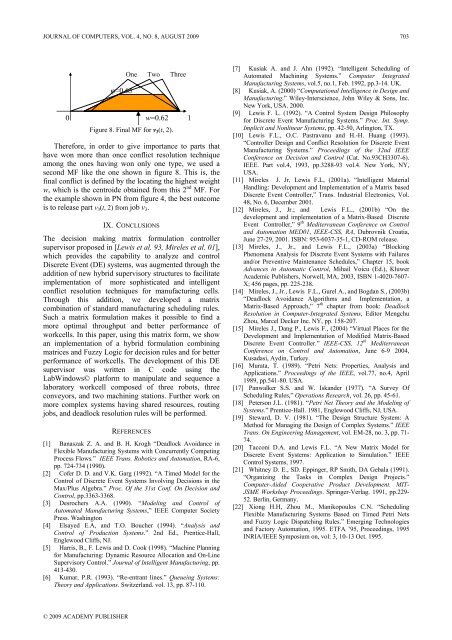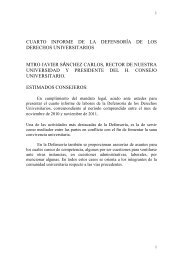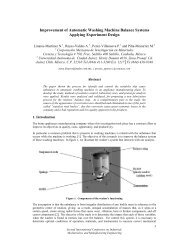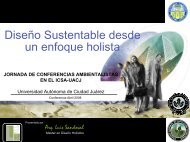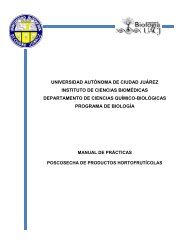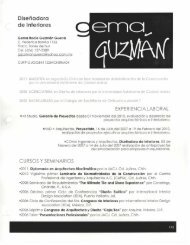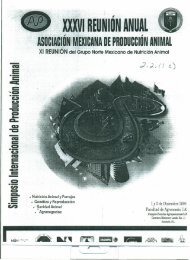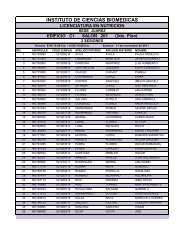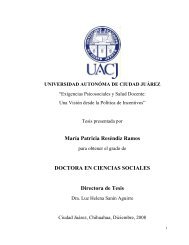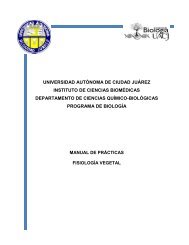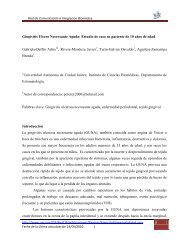journal of computers issn 1796-203x - Universidad Autónoma de ...
journal of computers issn 1796-203x - Universidad Autónoma de ...
journal of computers issn 1796-203x - Universidad Autónoma de ...
You also want an ePaper? Increase the reach of your titles
YUMPU automatically turns print PDFs into web optimized ePapers that Google loves.
JOURNAL OF COMPUTERS, VOL. 4, NO. 8, AUGUST 2009 703<br />
φ=0.65<br />
One Two Three<br />
0 w=0.62 1<br />
Figure 8. Final MF for v3(t, 2).<br />
Therefore, in or<strong>de</strong>r to give importance to parts that<br />
have won more than once conflict resolution technique<br />
among the ones having won only one type, we used a<br />
second MF like the one shown in figure 8. This is, the<br />
final conflict is <strong>de</strong>fined by the locating the highest weight<br />
w, which is the centroi<strong>de</strong> obtained from this 2 nd MF. For<br />
the example shown in PN from figure 4, the best outcome<br />
is to release part v 3(t, 2) from job v3.<br />
IX. CONCLUSIONS<br />
The <strong>de</strong>cision making matrix formulation controller<br />
supervisor proposed in [Lewis et al. 93, Mireles et al. 01],<br />
which provi<strong>de</strong>s the capability to analyze and control<br />
Discrete Event (DE) systems, was augmented through the<br />
addition <strong>of</strong> new hybrid supervisory structures to facilitate<br />
implementation <strong>of</strong> more sophisticated and intelligent<br />
conflict resolution techniques for manufacturing cells.<br />
Through this addition, we <strong>de</strong>veloped a matrix<br />
combination <strong>of</strong> standard manufacturing scheduling rules.<br />
Such a matrix formulation makes it possible to find a<br />
more optimal throughput and better performance <strong>of</strong><br />
workcells. In this paper, using this matrix form, we show<br />
an implementation <strong>of</strong> a hybrid formulation combining<br />
matrices and Fuzzy Logic for <strong>de</strong>cision rules and for better<br />
performance <strong>of</strong> workcells. The <strong>de</strong>velopment <strong>of</strong> this DE<br />
supervisor was written in C co<strong>de</strong> using the<br />
LabWindows© platform to manipulate and sequence a<br />
laboratory workcell composed <strong>of</strong> three robots, three<br />
conveyors, and two machining stations. Further work on<br />
more complex systems having shared resources, routing<br />
jobs, and <strong>de</strong>adlock resolution rules will be performed.<br />
REFERENCES<br />
[1] Banaszak Z. A. and B. H. Krogh “Deadlock Avoidance in<br />
Flexible Manufacturing Systems with Concurrently Competing<br />
Process Flows.” IEEE Trans. Robotics and Automation, RA-6,<br />
pp. 724-734 (1990).<br />
[2] C<strong>of</strong>er D. D. and V.K. Garg (1992). “A Timed Mo<strong>de</strong>l for the<br />
Control <strong>of</strong> Discrete Event Systems Involving Decisions in the<br />
Max/Plus Algebra.” Proc. Of the 31st Conf. On Decision and<br />
Control, pp.3363-3368.<br />
[3] Desrochers A.A. (1990). “Mo<strong>de</strong>ling and Control <strong>of</strong><br />
Automated Manufacturing Systems,” IEEE Computer Society<br />
Press. Washington<br />
[4] Elsayed E.A, and T.O. Boucher (1994). “Analysis and<br />
Control <strong>of</strong> Production Systems.” 2nd Ed., Prentice-Hall,<br />
Englewood Cliffs, NJ.<br />
[5] Harris, B., F. Lewis and D. Cook (1998). “Machine Planning<br />
for Manufacturing: Dynamic Resource Allocation and On-Line<br />
Supervisory Control.” Journal <strong>of</strong> Intelligent Manufacturing, pp.<br />
413-430.<br />
[6] Kumar, P.R. (1993). “Re-entrant lines.” Queueing Systems:<br />
Theory and Applications. Switzerland. vol. 13, pp. 87-110.<br />
© 2009 ACADEMY PUBLISHER<br />
[7] Kusiak A. and J. Ahn (1992). “Intelligent Scheduling <strong>of</strong><br />
Automated Machining Systems.” Computer Integrated<br />
Manufacturing Systems, vol.5, no.1, Feb. 1992, pp.3-14. UK.<br />
[8] Kusiak, A. (2000) “Computational Intelligence in Design and<br />
Manufacturing.” Wiley-Interscience, John Wiley & Sons, Inc.<br />
New York, USA. 2000.<br />
[9] Lewis F. L. (1992). “A Control System Design Philosophy<br />
for Discrete Event Manufacturing Systems.” Proc. Int. Symp.<br />
Implicit and Nonlinear Systems, pp. 42-50, Arlington, TX.<br />
[10] Lewis F.L., O.C. Pastravanu and H.-H. Huang (1993).<br />
“Controller Design and Conflict Resolution for Discrete Event<br />
Manufacturing Systems.” Proceedings <strong>of</strong> the 32nd IEEE<br />
Conference on Decision and Control (Cat. No.93CH3307-6).<br />
IEEE. Part vol.4, 1993, pp.3288-93 vol.4. New York, NY,<br />
USA.<br />
[11] Mireles J. Jr, Lewis F.L, (2001a). “Intelligent Material<br />
Handling: Development and Implementation <strong>of</strong> a Matrix based<br />
Discrete Event Controller,” Trans. Industrial Electronics, Vol.<br />
48, No. 6, December 2001.<br />
[12] Mireles, J., Jr.; and Lewis F.L., (2001b) “On the<br />
<strong>de</strong>velopment and implementation <strong>of</strong> a Matrix-Based Discrete<br />
Event Controller,” 9 th Mediterranean Conference on Control<br />
and Automation MED01, IEEE-CSS, RA, Dubrovnik Croatia,<br />
June 27-29, 2001. ISBN: 953-6037-35-1, CD-ROM release.<br />
[13] Mireles, J., Jr., and Lewis F.L., (2003a) “Blocking<br />
Phenomena Analysis for Discrete Event Systems with Failures<br />
and/or Preventive Maintenance Schedules,” Chapter 15, book<br />
Advances in Automatic Control, Mihail Voicu (Ed.), Kluwer<br />
Aca<strong>de</strong>mic Publishers, Norwell, MA, 2003, ISBN 1-4020-7607-<br />
X; 456 pages, pp. 225-238.<br />
[14] Mireles, J., Jr., Lewis F.L., Gurel A., and Bogdan S., (2003b)<br />
“Deadlock Avoidance Algorithms and Implementation, a<br />
Matrix-Based Approach,” 7 th chapter from book: Deadlock<br />
Resolution in Computer-Integrated Systems, Editor Mengchu<br />
Zhou, Marcel Decker Inc. NY, pp. 158-207.<br />
[15] Mireles J., Dang P., Lewis F., (2004) “Virtual Places for the<br />
Development and Implementation <strong>of</strong> Modified Matrix-Based<br />
Discrete Event Controller.” IEEE-CSS, 12 th Mediterranean<br />
Conference on Control and Automation, June 6-9 2004,<br />
Kusadasi, Aydin, Turkey.<br />
[16] Murata, T. (1989). “Petri Nets: Properties, Analysis and<br />
Applications.” Proceedings <strong>of</strong> the IEEE, vol.77, no.4, April<br />
1989, pp.541-80. USA.<br />
[17] Panwalker S.S. and W. Iskan<strong>de</strong>r (1977). “A Survey Of<br />
Scheduling Rules,” Operations Research, vol. 26, pp. 45-61.<br />
[18] Peterson J.L. (1981). “Petri Net Theory and the Mo<strong>de</strong>ling <strong>of</strong><br />
Systems.” Prentice-Hall. 1981, Englewood Cliffs, NJ, USA.<br />
[19] Steward, D. V. (1981). “The Design Structure System: A<br />
Method for Managing the Design <strong>of</strong> Complex Systems.” IEEE<br />
Trans. On Engineering Management, vol. EM-28, no. 3, pp. 71-<br />
74.<br />
[20] Tacconi D.A. and Lewis F.L. “A New Matrix Mo<strong>de</strong>l for<br />
Discrete Event Systems: Application to Simulation.” IEEE<br />
Control Systems, 1997.<br />
[21] Whitney D. E., SD. Eppinger, RP Smith, DA Gebala (1991).<br />
“Organizing the Tasks in Complex Design Projects.”<br />
Computer-Ai<strong>de</strong>d Cooperative Product Development. MIT-<br />
JSME Workshop Proceedings. Springer-Verlag. 1991, pp.229-<br />
52. Berlin, Germany.<br />
[22] Xiong H.H, Zhou M., Manikopoulos C.N. “Scheduling<br />
Flexible Manufacturing Systems Based on Timed Petri Nets<br />
and Fuzzy Logic Dispatching Rules.” Emerging Technologies<br />
and Factory Automation, 1995. ETFA ’95, Proceedings, 1995<br />
INRIA/IEEE Symposium on, vol: 3, 10-13 Oct. 1995.


